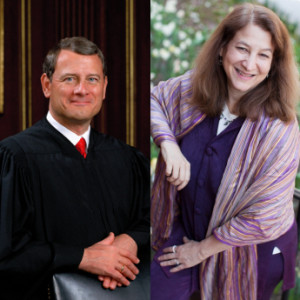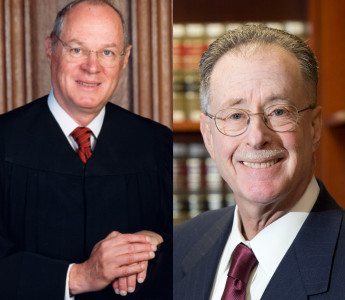Foster v. Chatman, 578 U.S. ___ (2016) (Roberts, C.J.).
Response by Phyllis Goldfarb
Geo. Wash. L. Rev. On the Docket (Oct. Term 2015)
Slip Opinion | New York Times | SCOTUSblog
E-Racing the White Jury’s Constitutional Veneer
When Stephen Bright, a well-known capital defense attorney, began his oral argument before the Supreme Court in Foster v. Chatman,1 the clock in the courtroom was malfunctioning. The image of the broken clock in the background provided an apt visual metaphor for the arguments in the foreground about egregious race discrimination in jury selection in a Georgia capital case. Foster v. Chatman was yet another skirmish in the century-and-a-half battle for the right of African-Americans to serve on juries, a battle that promised to continue no matter how the case was resolved. In a meaningful sense, our social and political culture remains caught in time, our historical commitment to ideologies of racial difference undermining our professed interest in equality. The march of decades has not healed our racial wounds, or brought to courtrooms around the country the civil rights progress imagined nearly 150 years ago when all citizens were guaranteed equal protection of the laws.
Foster v. Chatman began when Timothy Foster, a young, intellectually disabled African-American man, was convicted of the murder of an elderly white woman in Rome, Georgia and sentenced to death by an all-white jury, after prosecutors used peremptory challenges to strike all the eligible black jurors from the jury venire. After Foster challenged the constitutionality of the prosecutors’ strikes, the trial court found them racially neutral, a finding upheld by the Georgia Supreme Court, first on direct appeal and once again after a state habeas hearing. Upon reviewing the factual record, seven members of the Supreme Court—all but Justice Thomas, who wrote a lone dissent—reversed Foster’s conviction and remanded the case for further proceedings. Writing for the majority, Justice Roberts held that the state court’s finding of race neutrality was clearly erroneous.2 Instead the record showed that prosecutors were motivated in substantial part by race when they struck two of the prospective black jurors.
Since the late 19th century, American law has recognized a defendant’s constitutional right to be tried by a jury chosen without regard to race. Nonetheless, numerous studies document the continuing underrepresentation of minorities, especially African-Americans, on juries in criminal cases.3 The disproportionate exclusion of African-Americans is facilitated by the use of peremptory challenges that enable a prosecutor to remove eligible jurors without offering reasons.
The disconnect between equal protection principles and jury selection practices lies in the evidentiary burden that courts have placed on defendants to prove that a prosecutor engaged in purposeful discrimination. In Batson v. Kentucky,4 the Supreme Court held that once a defendant makes a prima facie case that a prosecutor’s peremptory strike has been exercised on the basis of race, then the burden shifts to the prosecutor to provide legitimate race-neutral reasons for the strike, and the judge must determine whether the race-neutral reasons are a pretext for purposeful discrimination.5 In most courts, obtaining a finding of purposeful discrimination even after racially suggestive strikes has been, and remains, notoriously difficult. Typically prosecutors do not acknowledge racial motivations. Rather, they routinely offer ostensibly neutral reasons for striking jurors of color, trial judges tend to accept these reasons at face value, and appellate judges generally defer to the trial court’s findings.
Foster’s case originally conformed to this pattern. The prosecutors’ peremptory challenges that produced an all-white jury were repeatedly upheld by Georgia’s trial and appellate courts. Then nearly 20 years after Foster’s conviction and sentence, Steve Bright—who represented Foster at state habeas—sought and received under Georgia’s Open Records Act the trial prosecutors’ case file. Its contents were astounding.
The prosecutors’ file contained damning evidence of race-based jury selection, an “arsenal of smoking guns,” to quote Bright at oral argument.6 These smoking guns included: 1) four separately annotated copies of a list of prospective jurors which highlighted all black jurors’ names in green and indicated in the upper right corner that green highlights designated blacks; 2) the letter B written next to the names of each of the prospective black jurors, three of whom were designated in other notes as B#1, B#2, and B#3; 3) the race of each of the black jurors circled on their jury questionnaires; 4) another list titled “Definite NO’s [sic]” containing six names, the first five of whom were the eligible black jurors, and yet another handwritten document with “NO” written next to the words “Black Church”; and 5) the draft of an affidavit, written by the prosecutor’s investigator, naming one black juror who “might be okay” if “it comes down to having to pick one of the black jurors….”7 Faced with a state habeas record containing overwhelming evidence of racially motivated peremptory challenges—in the words of Justice Kagan at oral argument, “as clear a Batson violation as a court is ever going to see”8—the Supreme Court straightforwardly applied established law. To have done otherwise would have drained Batson of all meaning, and the Court wisely refrained from eviscerating its prior precedent.
While applying established law and not eviscerating precedent are better than the alternative—and the Court raised but ultimately rejected an unbriefed alternative argument that it lacked jurisdiction and could avoid deciding the case on its merits—Foster v. Chatman does not promise to diversify juries in any discernable way. To have upheld a finding of race neutrality on a record like this would have been scandalous, yet there is nothing in Foster v. Chatman suggesting that courts should heighten their scrutiny of a prosecutor’s peremptory challenges to jurors of color. To the contrary, Roberts’s opinion, while worded sharply, is not written broadly. It is tied to the specific requirements of Batson and to the specific facts of Foster, some of which are exceedingly unusual.
Rarely does a defense attorney gain access to a prosecutor’s trial preparation file and, in those scattered instances, rarely will that file document the racial thinking of a prosecutor and contradict his/her assertions of facially and racially neutral reasons for exercising peremptory strikes against jurors of color. The steep burden of proving purposeful discrimination in the use of peremptory strikes remains on the capital defendant, even though social scientists have demonstrated that discrimination is not simply a problem of conscious discriminatory intent.9 In other words, in the absence of “an arsenal of smoking guns,” such as the distinctive documents found in Foster, judges are likely to continue accepting the sometimes pretextual reasons proffered by prosecutors for using available procedures to seat predominantly white juries.
Alarmingly, Justice Roberts observes in the majority opinion that the prosecutors’ stated reasons for removing each black juror “[o]n their face…seem reasonable enough.”10 This language suggests that were it not for the belated revelations in the prosecutors’ notes, Foster’s Batson challenge would have continued to fall short, as it had with the state’s trial and appellate judges (some of them ruling even after disclosure of the smoking guns). Yet race-based discrimination is often what lies beneath the commonly stated reasons for removing prospective jurors of color, and the reasons proffered in Foster surely had the ring of pretext: they were numerous, internally contradictory, raised concerns not addressed at voir dire, focused on issues seemingly irrelevant to jury service, misstated voir dire testimony, included questionable observations about demeanor and eye contact, exaggerated the record, quoted verbatim a reason that had been upheld in a prior reported case, and based strikes on grounds that were equally applicable to a number of white jurors selected.11
Herein lies the troubling underside of Foster v. Chatman. The majority opinion implies that even a prosecutor’s highly suspicious proffers—shown here to have been actual pretexts for race—are not enough on their own terms to support a finding of purposeful discrimination, even when the strikes they accompany remove all the eligible African-American jurors. In short, the majority did not identify a need to examine facially neutral yet suspicious-sounding justifications, to discern what lies beneath the removal of jurors of color, in the interests of “unceasing efforts to eradicate racial discrimination in the procedures used to select the venire….”12 Unless the Court requires a more searching examination of the reasons for peremptory strikes than it has thus far, most Batson challenges will fail. As a culture, we risk racial inequality more readily than we risk discomfiting constraints on courtroom processes and those who administer them.
As a consequence, African-Americans, living and working for years in a single county, may never have had the civic experience of serving on a jury. Instead, they have experienced repeated public exclusions that are difficult to understand except in terms of ideologies of race. Moreover, the systematic pattern of exclusions carries intimations that black jurors, unlike white jurors, cannot be trusted to decide a case fairly. Only white people can be entrusted with the decisionmaking authority to decide the fate of others, many of whom are African-American. In a setting where the lives and liberties of African-Americans are disproportionately at risk, courts continue to preside over practices which disproportionately block the democratic participation of African-Americans. Yet by and large judges label these practices fair, racially neutral, and constitutional.
What this picture illuminates is one of the structures of institutionalized race subordination, which combines with other structures to produce manifestly unequal results. For example, in Foster’s case, after striking all of the eligible black jurors, the prosecutor argued to the white jurors that they should sentence Foster to death to “deter other people out there in the projects.”13 (Although the petitioner’s brief repeatedly notes the prosecutor’s racially coded argument, the majority opinion makes no reference to it.) Like Foster, more than 90% of the occupants in the housing projects in Rome, Georgia were African-American. The white prosecutor was calling on his community of white citizens—the insiders—to condemn to death an African-American defendant to protect themselves against other African-Americans—the outsiders. The white jury obliged, sending a message about the racial identity of who exerts control and who must be controlled.
A more diverse jury might have been less receptive to such a racially inflammatory perspective. In fact, research has shown that diverse juries are better juries, spending more time considering evidence, making fewer errors, and considering more perspectives.14 We diminish the quality and the legitimacy of our much-vaunted jury system by continuing to allow it to operate in a racially unequal way.
While Foster v. Chatman did not exacerbate that centuries-old problem, neither has it ameliorated it. We can move the clocks forward only by insisting on fairer practices. These might include a lower burden of proof for Batson challenges, the reduction or elimination of peremptory strikes, the creation of more representative lists of jury pools, or a willingness to discipline prosecutors who mislead courts and even commit perjury to mask racially motivated actions. Overcoming a legacy of racism in criminal justice to enforce our own laws in a truly egalitarian fashion may require a variety of approaches, but all of them begin with the willingness to acknowledge and prohibit not just the rare instance of starkly exposed inequity, as Foster did, but what lies beneath the invidious exclusions we witness day to day.
- Foster v. Chatman, No. 14-8349, slip. op. (U.S. May 23, 2016).
- See id. at 25 (majority opinion).
- Equal Justice Initiative, Illegal Racial Discrimination in Jury Selection: A Continuing Legacy (2010), http://www.eji.org/files/EJI%20Race%20and%20Jury%20Report.pdf; Ursula Noye, Blackstrikes: A Study of the Racially Disparate Use of Peremptory Challenges by the Caddo Parish District Attorney’s Office (Reprieve Australia, 2015), http://blackstrikes.com/resources/Blackstrikes_Caddo_Parish_August_2015.pdf; Adam Liptak, Exclusion of Blacks From Juries Raises Renewed Scrutiny, N.Y. Times (Aug. 16, 2015), http://www.nytimes.com/2015/08/17/us/politics/exclusion-of-blacks-from-juries-raises-renewed-scrutiny.html.
- Batson v. Kentucky, 476 U.S. 79 (1986).
- Foster, slip op. at 9 (majority opinion) (quoting Snyder v. Louisiana, 552 U.S. 472, 476–77 (2008)).
- Transcript of Oral Argument at 25, Foster v. Chatman, (Nov. 2, 2015) (No. 14-8349).
- Foster, slip op. at 3-5 (majority opinion).
- Transcript of Oral Argument at 38-39, Foster v. Chatman, (Nov. 2, 2015) (No. 14-8349).
- See Implicit Racial Bias Across the Law (Justin D. Levinson & Robert J. Smith eds., 2012); Christine Jolls & Cass R. Sunstein, The Law of Implicit Bias, 94 Cal. L. Rev. 969 (2008); Jerry Kang, Trojan Horses of Race, 118 Harv. L. Rev. 1489 (2005).
- Foster, slip. op. at 12 (majority opinion).
- See id. at 12–22 (majority opinion).
- Batson, 476 U.S. at 85 (majority opinion).
- Brief of Petitioner at i, 24, 49, Foster v. Chatman, No. 14-8349.
- See Samuel R. Sommers, On Racial Diversity and Group Decision Making: Identifying Multiple Effects of Racial Composition on Jury Deliberations, 90 J. Personality & Soc. Psychol. 597 (2006).
Recommended Citation:
Phyllis Goldfarb, Response, Foster v. Chatman: E-Racing the White Jury’s Constitutional Veneer, Geo. Wash. L. Rev. On the Docket (May 29, 2016), https://www.gwlr.org/foster-v-chatman-e-racing-the-white-jurys-constitutional-veneer-examining-what-lies-beneath.





